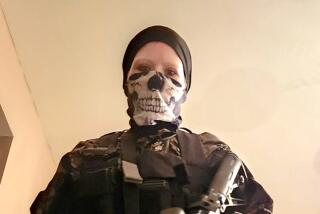‘The Way of the Knife’ exposes America’s shadow wars
In October 2002, Barack Obama, then an obscure state senator in Illinois, stood in Federal Plaza in Chicago and gave a speech about Iraq that launched his career toward the White House.
“I don’t oppose all wars,” Obama told the crowd. “What I am opposed to is a dumb war.”
More than a decade later, Obama’s vision of a smart war — or at least a new way of war — is clear, even if he has not publicly articulated it. He has presided over a vast expansion of CIA and Pentagon authorities to secretly kill thousands of people around the globe, relying on missile-firing drone aircraft, special operations teams, mercenaries and privateers.
History will decide whether Obama championed a counter-terrorism policy that contained a national threat at low cost and little risk — or if he authorized targeted killings (critics call them extra-judicial executions) on such a sanguinary scale that America made more enemies than it eliminated.
In “The Way of the Knife,” Mark Mazzetti pulls back some of the veils from America’s ongoing shadow wars in Pakistan, Yemen, Somalia and elsewhere. The full story probably won’t emerge for years, and this often colorful account raises as many questions as it answers. But Mazzetti finds new details and tracks the ominous blurring of traditional roles between soldiers and spies, the lush growth of a military-intelligence complex, and what the shift portends for the future.
Mazzetti covers national security at the New York Times, where he regularly breaks scoops. For his first book, he seems to have emptied his notebooks of nuggets — a U.S. drone strike in the Philippines, an eavesdropping device called “typhoon box,” a failed military operation code-named “celestial balance” in Somalia — in a sometimes jumpy narrative. But it is a valuable addition to a canon that is exposing America’s use of lethal operations far from declared war zones.
The history, at least, is familiar. The CIA had run into a political buzz saw in the early 1970s for harebrained assassination plots — one involved giving Fidel Castro an exploding cigar — and again after the Iran-Contra mess in the 1980s. People were hauled before congressional committees and convicted at criminal trials. After that, especially with the fall of the Soviet Union, the CIA largely abandoned sabotage, coups and paramilitary operations and focused instead on stealing secrets from foreign governments, the traditional role of an espionage agency.
But soon after the terrorist attacks of Sept. 11, 2001, the CIA was killing dozens of people in Afghanistan with a weapon tested for the first time only six months earlier: a Predator drone armed with a Hellfire missile. It was the perfect weapon for a spy service: It killed from afar, usually out of public view and without accountability. It was the start of remote-controlled war (although not “killer robots,” as Mazzetti incorrectly writes), the policy that Obama ultimately embraced.
With the dawn of the drone age, the CIA got a license to kill. Since then, the author warns, it has become “a killing machine, an organization consumed with man hunting.” The CIA director has become a “military commander running a clandestine global war with … very little oversight.” It is the “willing executioner of America’s enemies.” It has “gone on a killing spree.” And so on.
The drones hit hardest in northwest Pakistan, partly because the CIA obtained White House approval to carry out missile strikes there even if it didn’t know who it was killing. So-called signature strikes targeted patterns of activity, such as clusters of “military-aged males” at a suspected militant camp. It’s one reason the CIA claims it has killed almost no civilians: It lists everyone as a combatant unless explicit intelligence posthumously proves him innocent. Needless to say, most Pakistanis don’t agree.
In the meantime, the CIA — which famously learned about the toppling of the Berlin Wall on CNN — was caught flat-footed by the Arab Spring uprisings in 2011 that ousted pro-Western autocrats in Tunisia and Egypt and ultimately drew America into a war in Libya. Later that year, America’s estimated $80-billion-a-year spy system failed to learn for several days that Kim Jong Il, leader of nuclear-armed North Korea, had died.
The military, in turn, “has been dispersed into the dark spaces of American foreign policy,” Mazzetti writes, and is running more spying missions than ever before. It’s a tricky business because spies operate under a U.S. law that allows secrecy and lying, and the military fights under a separate legal code. So the Pentagon has relied chiefly on private contractors, one more colorful than the next, and the Joint Special Operations Command, or JSOC.
Operating in almost total secrecy, JSOC got its own stealth air force, its own communications satellites, its own drones. Most Americans learned of JSOC only after the raid that killed Osama bin Laden in May 2011 in Pakistan. The CIA ran the assault to give the Navy SEALs legal cover for the covert mission. A CIA operation is one thing; a military raid could be an act of war.
Soon after, Obama reshuffled his senior national security team. The results symbolized how intertwined U.S. military and intelligence operations have become. He moved the CIA director, Leon Panetta, over to the Pentagon. And he named Army Gen. David Petraeus, the most lauded general of his generation (until a sex scandal brought him down) to head the CIA. During his brief tenure, Petraeus expanded the drone fleet and told Congress that the CIA was conducting more covert action operations than at any time in its history.
Petraeus oversaw the first targeted killing by the CIA of a U.S. citizen, an Al Qaeda operational leader named Anwar Awlaki, in Yemen. The same drone strike (two CIA Predators locked onto the vehicles with lasers and a Reaper drone fired the missiles) killed another American, Samir Khan, who was not on the U.S. kill list. Two weeks later, a JSOC drone launched a missile at an open-air restaurant. Among the dead — and also not a target — was Awlaki’s 16-year-old son, born in Denver. The CIA and JSOC were running two distinct, competing drone wars in Yemen and killed three Americans in short order.
Most Americans, fatigued by the grinding wars in Iraq and Afghanistan, seem little concerned about the shadow wars. They should be. As a former CIA officer explains, “Every drone strike is an execution. And if we are going to hand down death sentences, there ought to be some public accountability and some public discussion about the whole thing.” Except for books like this, there is neither.
Drogin, Washington deputy bureau chief of the Los Angeles Times, is author of “Curveball: Spies, Lies and the Con Man Who Caused a War.”
The Way of the Knife
The CIA, a Secret Army, and a War at the Ends of the Earth
Mark Mazzetti
Penguin Press: 400 pp., $29.95
More to Read
Sign up for our Book Club newsletter
Get the latest news, events and more from the Los Angeles Times Book Club, and help us get L.A. reading and talking.
You may occasionally receive promotional content from the Los Angeles Times.









